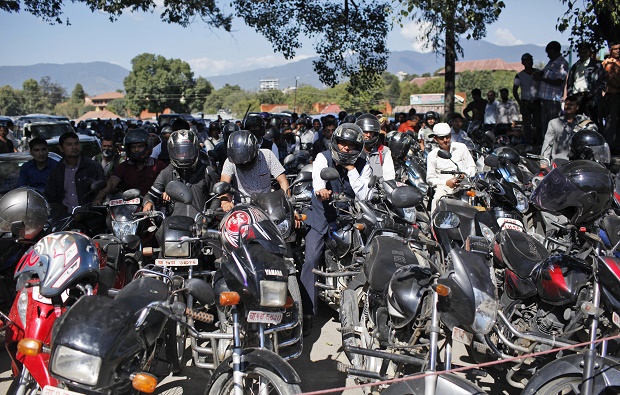
Nepalese people wait for their turn to fill fuel In their motorbikes at gas station run by Nepalese army in Kathmandu, Nepal, Thursday, Oct. 8, 2015. Struggling with a fuel shortage after Indian shipments went on hold, Nepal is asking suppliers to bring gasoline and kerosene by airplane before the Himalayan country begins celebrating its biggest festival of the year, and for the first time is looking to import fuel from China. AP
KATHMANDU, Nepal — Nepal’s fuel crisis eased slightly as the Himalayan nation began issuing gasoline for private vehicles while also reopening a northern border crossing with China that had been damaged by April’s devastating earthquake.
Lines of cars and motorcycles stretched for kilometers (miles) from gasoline pumps in Kathmandu on Tuesday, as people rushed to fill up before the Hindu festival of Dasain, the country’s biggest holiday. The government said it was allowing only a one-time sale of 15 liters (4 gallons) per vehicle until the fuel shortage is over.
Meanwhile on the southern border, where supplies have been blocked for weeks by protests, 101 trucks including 63 carrying some type of fuel crossed Tuesday at the Jogbani border crossing, according to police official Pramod Kharel.
It was the biggest shipment of fuel into Nepal in more than two weeks.
Nepal has been hobbled by the fuel crisis, which started when Indian trucks began halting at the border after Nepal adopted a new constitution. The constitution angered ethnic Madhesi groups, who are now demanding it be amended.
Nepal accused India of imposing a blockade to force the government to meet the demands of Madhesis, who have close ties in India.
India denies there is any official blockade, saying truckers are simply afraid to cross into areas of protest. It has not explained why truckers were not afraid when the groups were protesting for weeks before the constitution was adopted.
Indian Oil Corp. — which supplies all of Nepal’s fuel — said only 6,000 tons of gasoline and diesel had been delivered in the first half of October — not even a quarter of the usual two-week supply of about 30,000 tons. The company has yet to assess its losses.
“There are security concerns,” said Indrajit Bose, a senior company official, explaining why the trucks haven’t crossed the border. “Even though the tankers have been loaded, the drivers are unwilling to go in.”
The main border point at Birgunj, which handles 60-70 percent of India-Nepal trade, remained closed Tuesday while protesters continued to rally on the Nepalese side. About 100 kilometers (62 miles) away at the crossing in Lahan, Madhesi villagers said they were also hard hit because of the fuel shortage, but would continue their protests.
“In the past, we have protested and we have been promised many things. But those promises were never kept. Now we will continue until our demands are met,” said 48-year-old Ashok Swanaar, accusing the government of dismissing Madhesis as “outsiders” despite their having lived in Nepal for generations.
The Madhesis oppose the new constitution because it divides Nepal into seven states, with some borders slicing through the Madhesis’ ancestral homeland in the southern plains. The Madhesis, along with several other small ethnic groups, want the states to be larger and to be given more autonomy over local matters.
Talks last week made little progress, though the country’s new prime minister appointed the leader of a smaller Madhesi group to be one of his deputy premiers. The larger group was unimpressed, and vowed to continue agitating until its demands were fully met.
“We will stop only after constitutional amendments have been made to address our demands,” said Upendra Yadav, one of the leaders of the United Democratic Madhesi Front.
Yadav said the group was asking for the state border to be adjusted, electoral constituencies redrawn, more parliamentary representation for ethnic minorities, and the guarantee of more government jobs.
Meanwhile in northern Nepal, a border point with China that was damaged by April’s devastating earthquake reopened Tuesday.
India and China are major trading partners of Nepal, which is sandwiched between the giant Asian rivals, but all traffic with China ceased when the two main trading points between the countries were badly damaged in the earthquake that killed thousands and left hundreds of thousands without homes.
On Tuesday, authorities reopened the high-altitude Jilung crossing linking Nepal with southwestern Tibet, which is generally used for bringing Chinese clothing, furniture, electronic goods and household items into Nepal, the point’s management committee head, Sun Lijun, told China’s official Xinhua News Agency.
But while officials were ready to process vehicles across the border, no trucks showed up on Tuesday, according to Nepalese customs official Durga Subedi.
RELATED STORIES
Nepalis adapt to fuel shortage by carpooling, riding bikes
Protests in Nepal causing shortages of gasoline, medicine